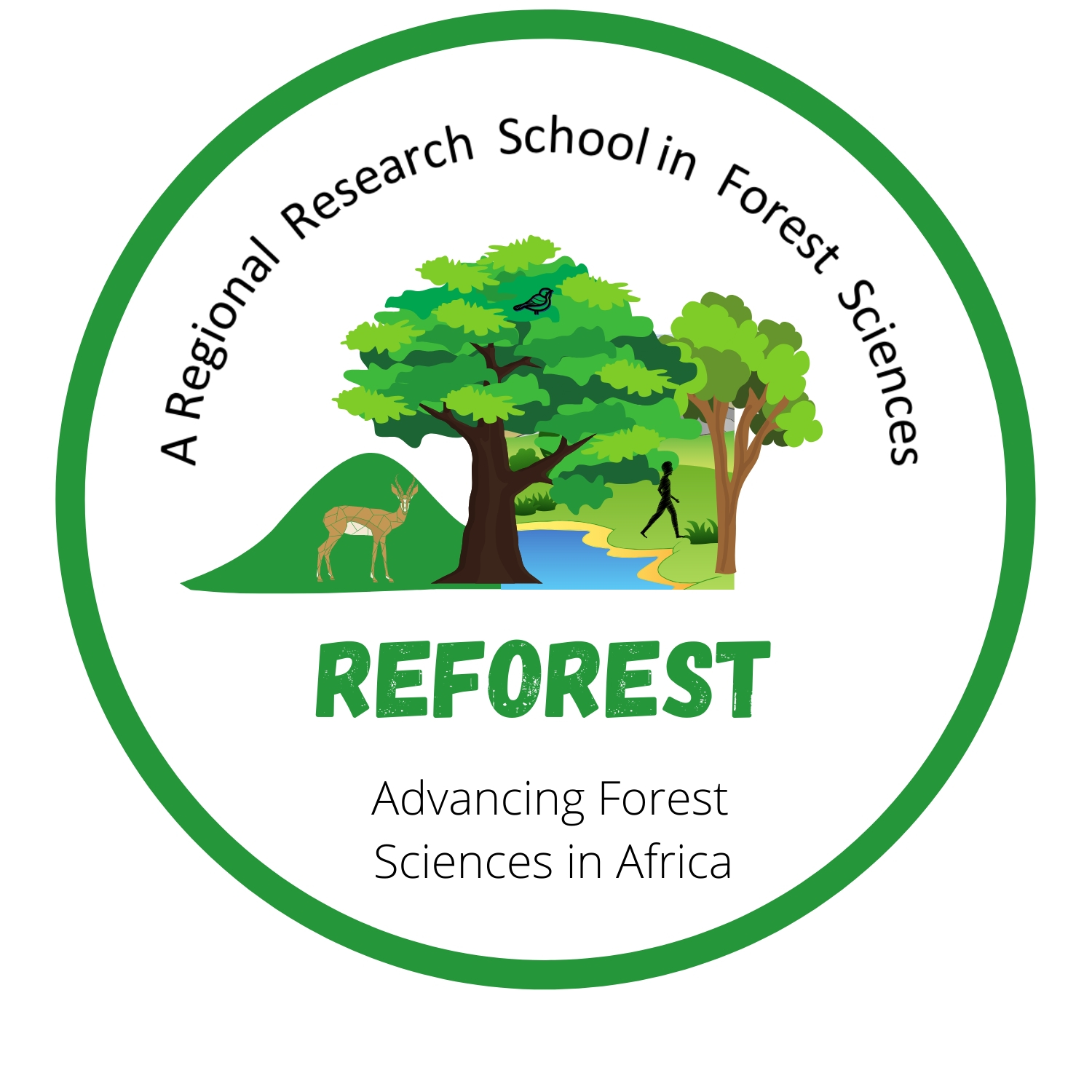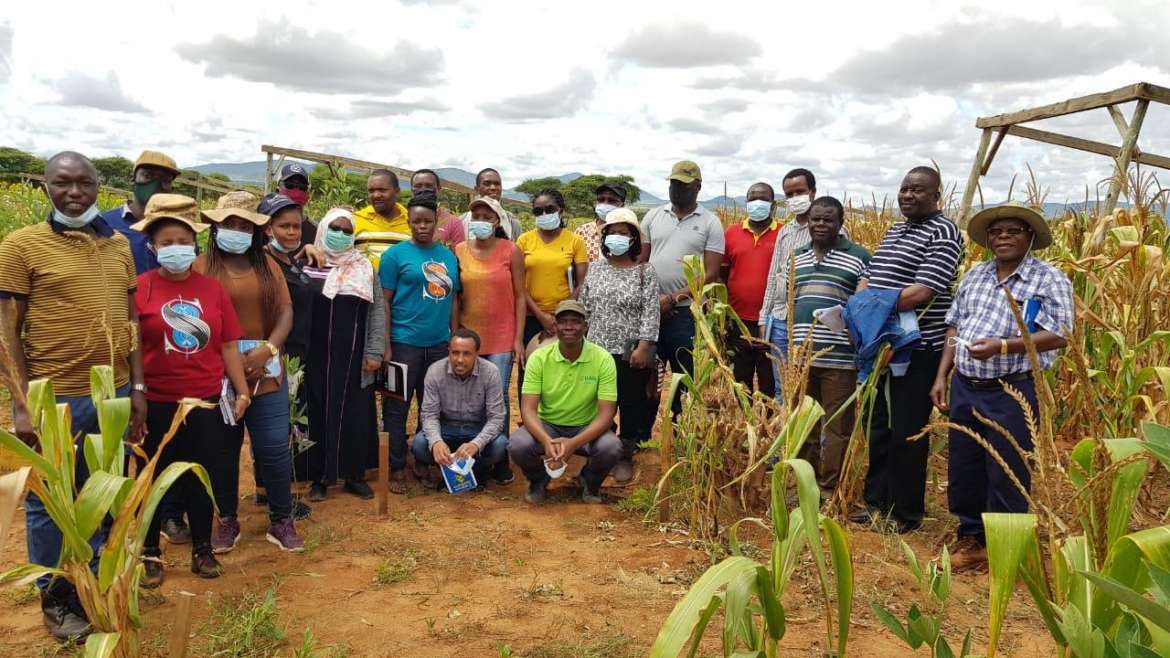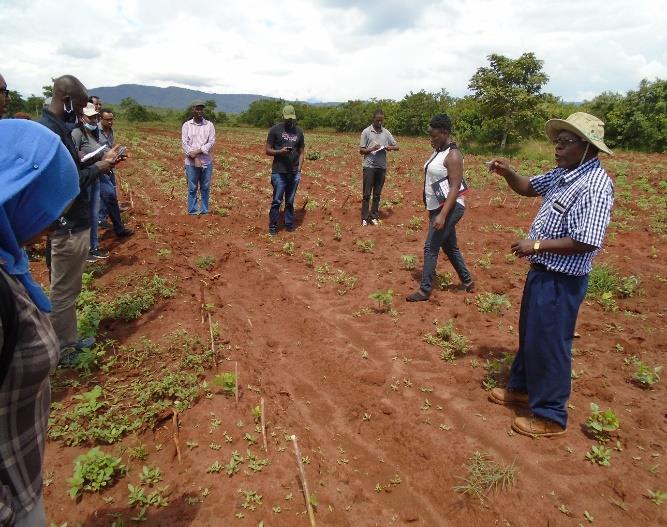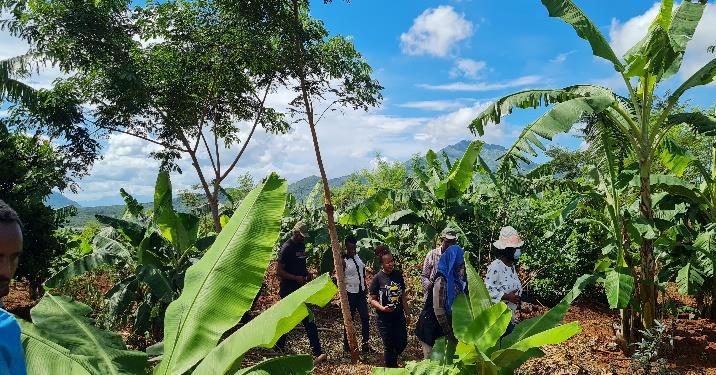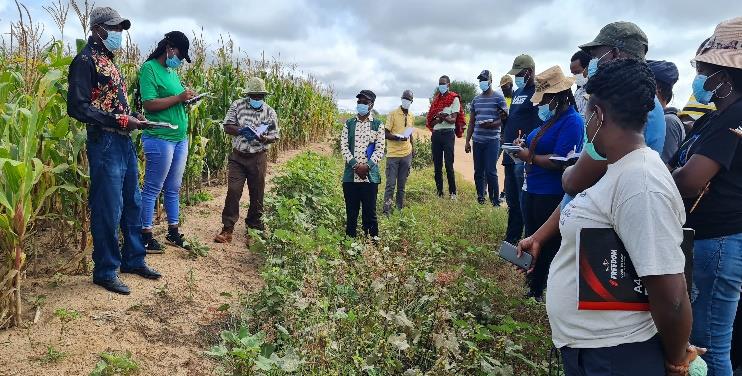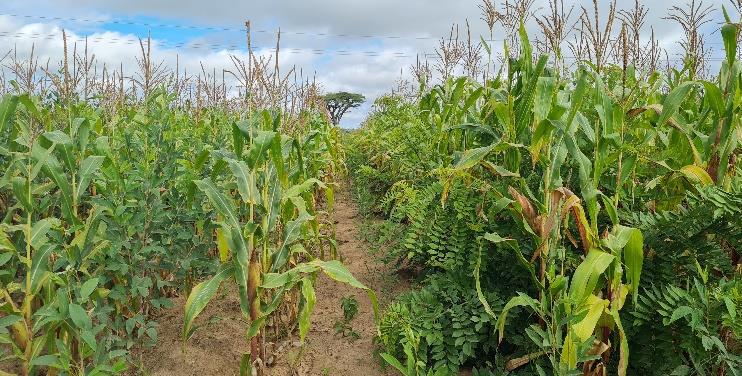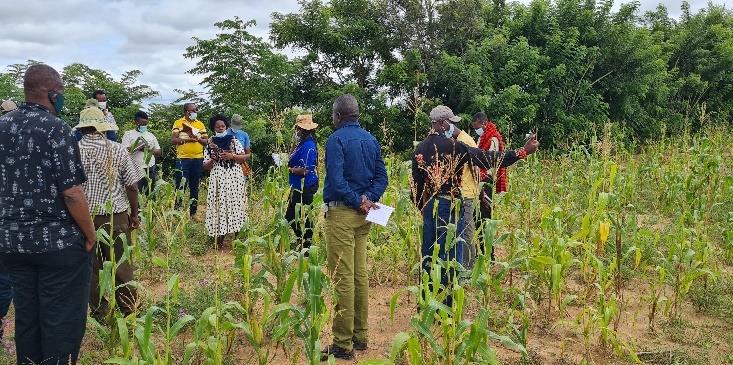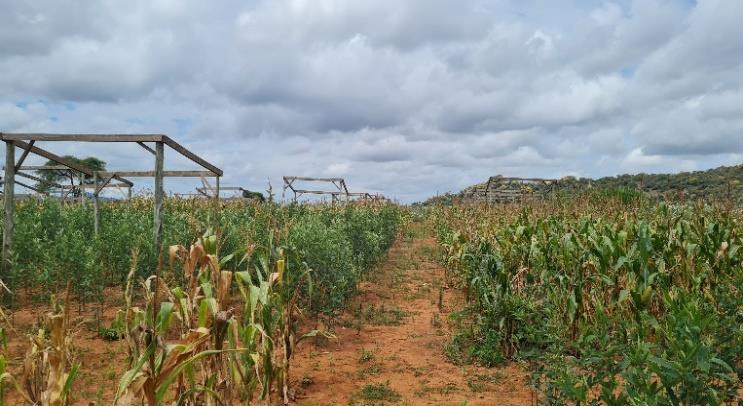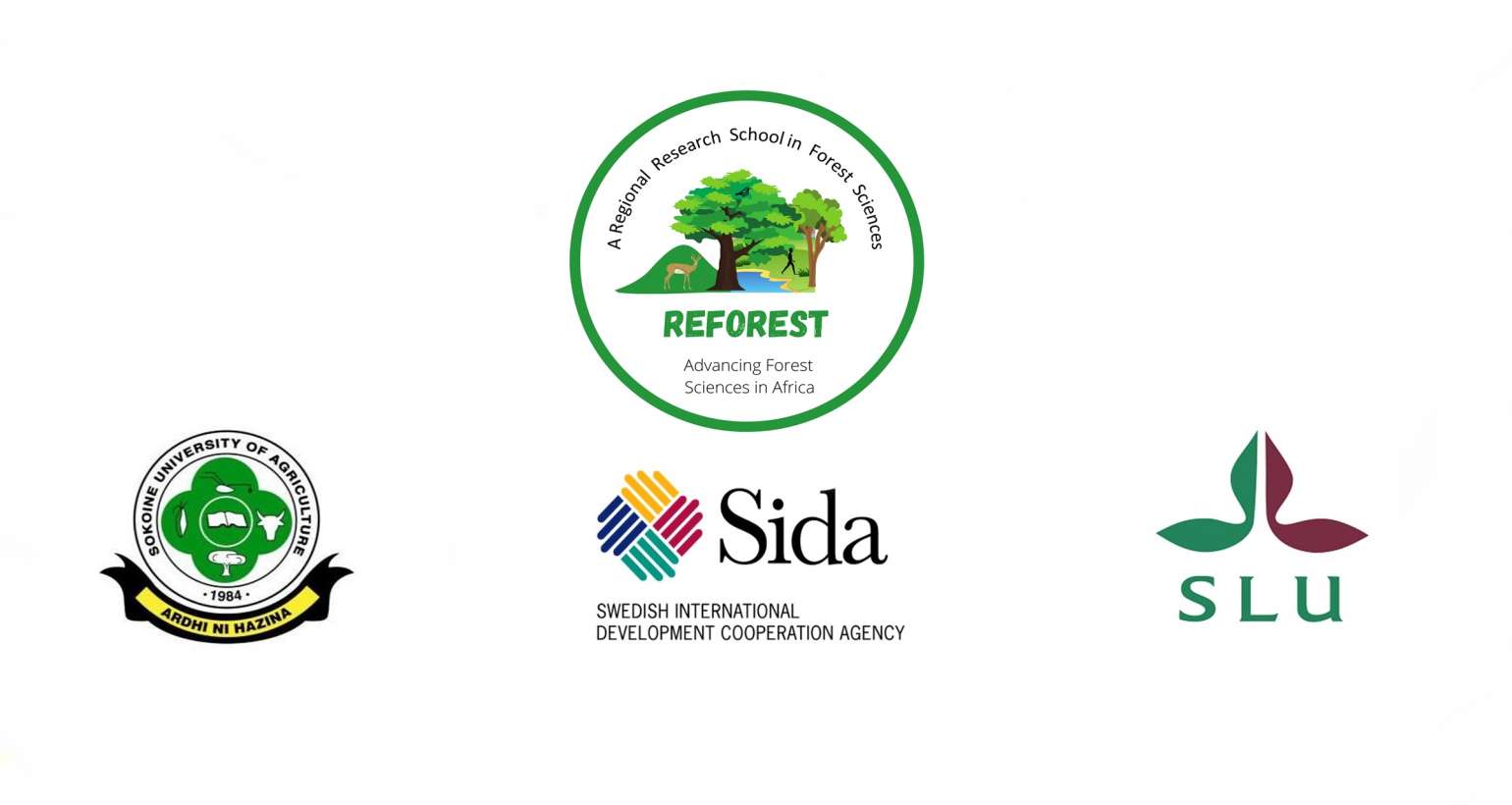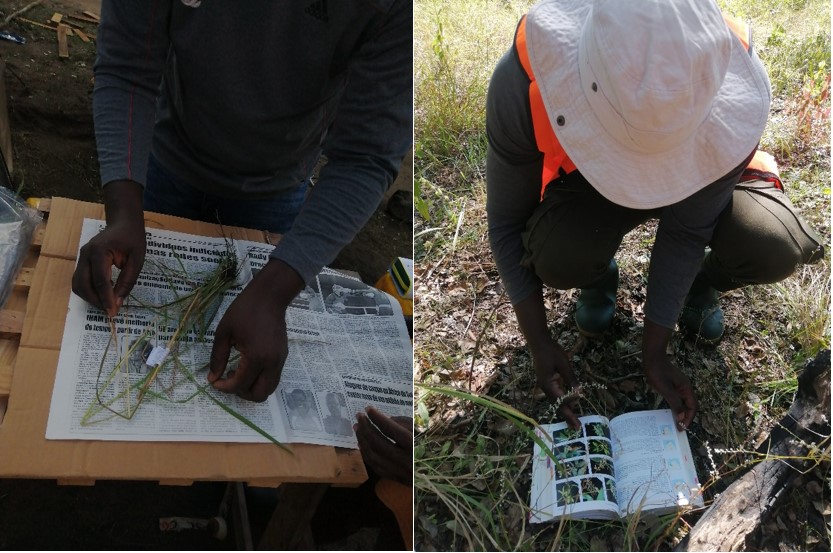PhD students and instructors from the Sida funded REFOREST Programme at Sokoine University of Agriculture (SUA) during the agroforestry field excursion to Morogoro and Dodoma regions. Background is the maize drought resistance experiment at Manyusi Village, Kongwa District (Photo credits: David Kissa).
The agroforestry field excursion for PhD students under the REFOREST Programme at Sokoine University of Agriculture was conducted in Morogoro and Dodoma regions from 24th – 26th April, 2021. The objectives of the excursion were to gain practical experience on agroforestry research and development activities.
During the field excursion, the students discussed about opportunities and challenges of agroforestry technologies promoted for land rehabilitation and for building resilient and productive agricultural systems in dryland areas. Drylands (Arid, semi-arid and dry sub-humid areas) cover about 61% of Tanzania and represent the region most vulnerable to the impacts of climate change in the country. Variability in rainfall patterns and temperature fluctuations are the main climate change related challenges to sustainable crops production in dryland ecosystems.
The adverse effects of climate change in the drylands of Tanzania include crop yield declines due to variability in rainfall and reduction in the length of the growing season, frequent droughts and floods due to high intensity and short duration rainfall which are poorly distributed throughout the cropping seasons, and high pest and disease incidence associated with increased temperatures.
Degradation of land and forest resources due to unsustainable wood harvesting, livestock grazing, and poor farming practices; aggravate the impacts of climate change on crop production and rural livelihoods in dryland areas. Also, the use of crop residues for firewood accelerates the depletion of soil nutrients and organic matter, increasing the vulnerability of dryland farming systems to drought and other climatic stresses.
High reliance of rainfall by small-scale farmers in dryland areas makes them more susceptible to the impacts of climate change. However, sustainable and climate resilient agricultural practices are promoted to improve food and nutrition security of farmers and to restore degraded landscapes. Diversification of cropping systems through intercropping with leguminous trees/shrubs and/or grain legumes is known to increase agroecosystem resilience and the adaptive capacity of small-scale farmers through efficient use of growth resources and diversification of production options and income sources.
In this context, the government of Tanzania, World Agroforestry (ICRAF), Sustainable Agriculture Tanzania (SAT) and other organizations in Tanzania are promoting climate resilient technologies to boost and sustain crops production semi-arid areas.
During the agroforestry field excursion, we got exposure to agroforestry technologies for semiarid areas in Morogoro and Dodoma regions. Discussions with farmers and experts from ICRAF and SAT provided practical experience on the impacts and challenges in conducting research and scaling agroforestry technologies this fragile ecosystem.
In Morogoro, we visited SAT’s demonstration plots and the home garden of a Lead Farmer (Mrs. Meena) to learn about agroforestry and organic farming technologies used for semiarid Morogoro. Mrs. Meena, is a farmer trained by SAT and she has adopted various technologies which support her life.
During our visits in Morogoro, we discussed several issues related to agroforestry technology design, management of tree-crop interactions to optimize productivity and other benefits of agroforestry, integrated pest management (IPM), soil and water conservation, SAT’s marketing strategies, and livelihoods impacts of agroforestry and organic farming technologies.
It was interesting to see the processing of manure tea from fresh cow dungs for soil fertility management and plant extracts for pest control at Mrs. Meena’s home garden. Mrs. Meena explained that she mainly produces organic vegetables and fruits (banana and rosella) and sales her produce at a premium price to the organic shop via SAT Holistic Group.
It was impressive to discuss the adoption and benefits (livelihoods, economic and environmental) of agroforestry and organic technologies with the farmer. Mrs. Meena was confident, knowledgeable and excited with technologies she is managing in her homegarden.
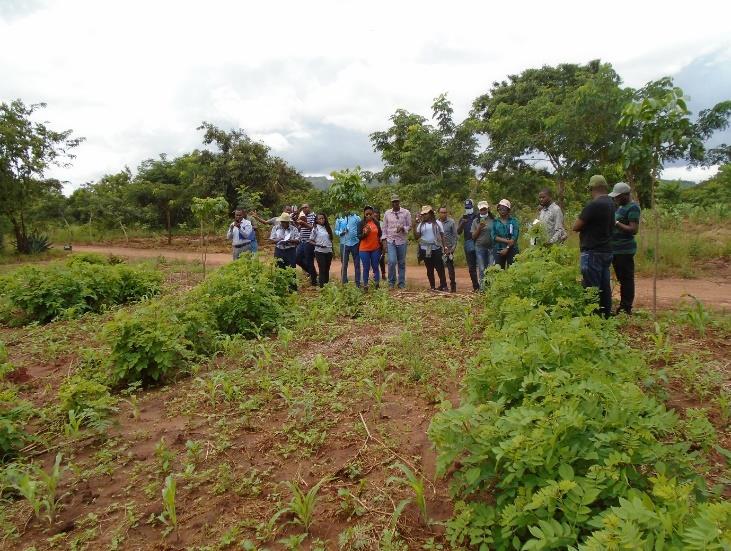 REFOREST PhD students discussing the design and management of G. sepium-maize intercropping system (Photo credits; David Kissa)
REFOREST PhD students discussing the design and management of G. sepium-maize intercropping system (Photo credits; David Kissa)
Instructor of the Advanced Agroforestry Course (Prof. Chamshama) discussing benefits of constructing water retention ditches, ridge planting and propagation methods (seed or cutting) of G. sepium at SAT’s training site (Photo credits; Daniel Obua)
Mrs. Meena’s home garden with trees (Albizia gummifera, G. sepium) and food crops (Banana, Pumpkin, cassava) (Photo credits; Anthony Kimaro)
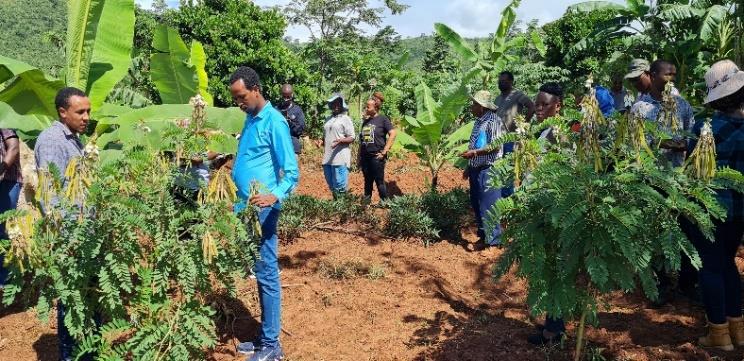
Students observing Tephrosia vogelii, one of the plants used for IPM by Mrs. Meena (Photo credits; Anthony Kimaro)
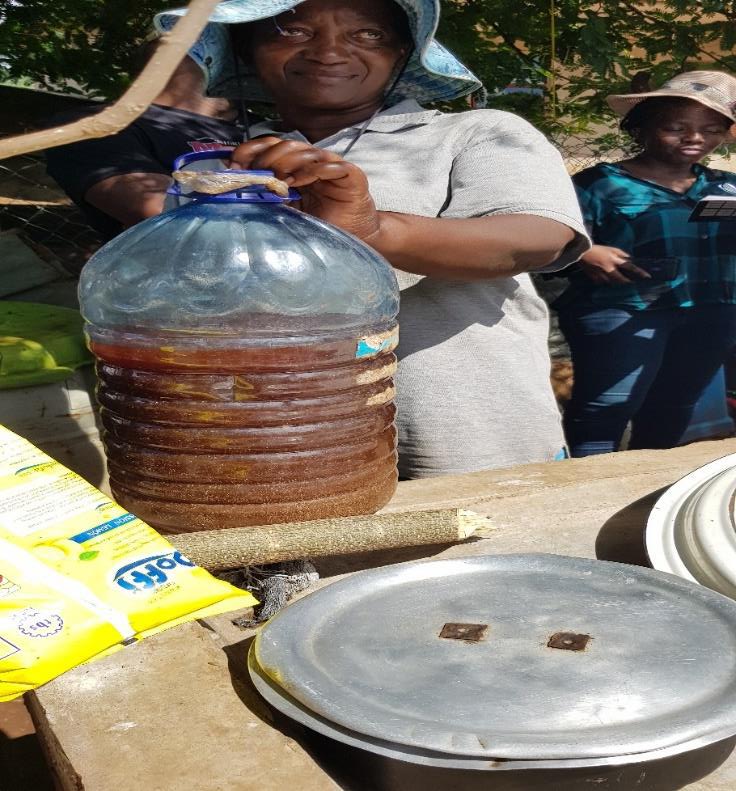
Mrs. Meena demonstrating how local concoctions of herbs are developed and used to control crop pests and diseases. (Photo credits; David Kissa)
Aspects of integrating agroforestry and soil and water conservation technologies for land rehabilitation and for enhancing resource use efficiency to improve the resilience of dryland farming systems and adaptive capacity of farmers were discussed in villages visited in Kongwa District, Dodoma.
Mr. Papius Charles is a Lead Farmer who is managing the mother trial site of intercropping maize with G. sepium and/or pigeonpea (Cajanus cajan) integrated rainwater harvesting using Chololo pits (Planting basin). The site was established by ICRAF in 2016 through the financial support from the USAID funded Africa RISING Programme.
My site was highly degraded like the sites of my neighbours, but after years of intercropping G. sepium and Pigeonpea land productivity has improved. Also, growth and yield of my maize crops are better and crops in my field can withstand drought much better than it used to be, says Mr. Papius.
Mrs. Winnie Saigodi practices shelterbelt also established as a demonstration site by ICRAF. Her site used to have gullies and not suitable for maize production such that she resorted to plant sunflower and groundnuts. But after establishing the shelterbelts and practicing good agronomic practices she learnt from ICRAF, gullies have disappeared, wind erosion is reduced substantially and she can grow maize again.
Initially, I had challenges of grazing animals damaging tree seedlings, but with support from the project and the village government, this problem was controlled and I now harvest wood each year that can sustain my 5-member family for six months, explained Mrs. Saigodi.
Interactions with the lead farmers in Dodoma sites (Mr. Papius Charles and Mrs. Winnie Saigodi) provided practical experience on the adaptation potential of dryland agroforestry technologies as we learned from users of technologies.
Dr. Anthony Kimaro from ICRAF also provided details of entry points for agroforestry work in Dodoma and the selection of technologies validated with farmers and included in the research (maize drought resistance experiment) to build the resilience of dryland farming systems and to increase adaptive capacity of small-scale farmers.
He indicated that integrating food and fodder crops in contour farming at Mlali village has diversified production options and income sources, reducing the risk of total crop failure even in cropping seasons when whether do not favour food crops production.
Mr. Papius Charles, the Lead Farmer at Molet Village, briefing PhD students from the REFOREST Programme at SUA on agroforestry technologies in his farm (Photo credits; Jimmy Sianga)
Maize-pigeon pea (PP)-Chololo pits and Gliricidia-pigeon pea-maize-Chololo pits technologies practiced by the farmer (Photo credits; Jimmy Sianga )
Mrs. Winnie Saigodi describing how the adoption of the shelterbelt technology has helped to reduce wind and gully erosion in her farm and increased fuelwood for domestic use (Photo credits; Anthony Kimaro)
The maize-drought resistance experiment at Manyusi village showing better crop growth in intercropped plots compared to maize monoculture plots. (Photo credits; Anthony Kimaro)
The field practical excursion was short but very informative in terms of research and development of agroforestry technologies for dryland farming. We covered a lot of issues related to topics in the Advanced Agroforestry Course, including agroforestry technology design, management of component (tree-crop) interactions and soil and water conservation, climate change mitigation and adaptation potential, and socio-economic and livelihood impacts of agroforestry.
It was clear that proper management of agroforestry practices can rehabilitate land, improve crop yields, enhance on-farm biodiversity and agroecosystem resilience in arid and semi-arid areas. However, to enhance wider adoption and utilization of promising agroforestry practices more extension services are needed to provide the knowledge required to manage tree-crop interactions to optimize productivity and other benefits of agroforestry in dryland areas.
Also effort to link farmers markets, as done by SAT, will improve income and provide economic incentives to accelerate adoption of agroforestry practices.
Prepared by REFOREST Programme students
